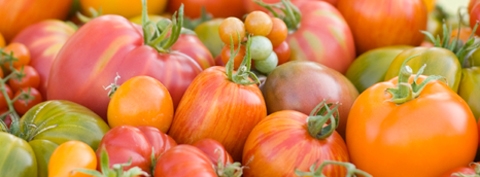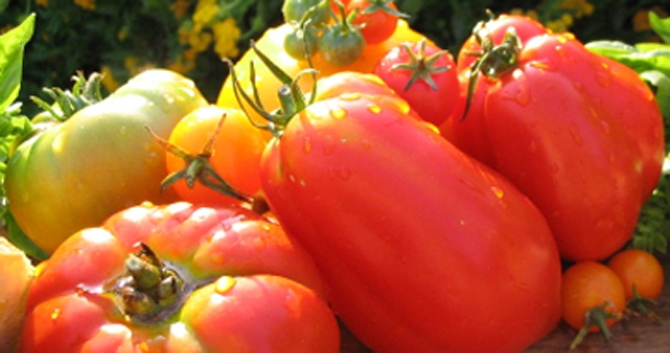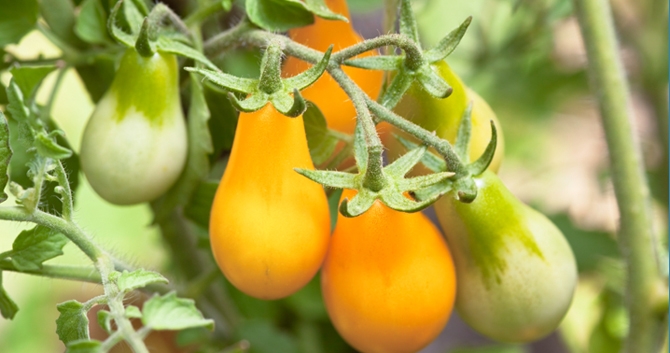Tomatoes
 Large beefsteak tomatoes are ideal for slicing and sandwiches.
Large beefsteak tomatoes are ideal for slicing and sandwiches.
Nothing compares to a tomato at the peak of ripeness, picked right from the vine, warmed by the sun and immediately sliced onto a plate, salad, or sandwich. The epitome of summer satisfaction, garden tomatoes are sorely missed the rest of the year, when only those disappointing commercially grown varieties that lack flavor, moisture, and tender loving care are available. Anticipation for these summer favorites begins as spring days warm and tomato plants arrive at the garden center.
Tomatoes are easy to grow in garden beds or containers -- with a few simple tips, you’ll be rewarded with bigger, healthier, and more abundant tomatoes.
Types of Tomatoes
When it comes to tomatoes, there’s no lack of variety in terms of size, shape, color, and flavor.
- Tiny cherry tomatoes in red, yellow, or orange are perfect for salads and snacks.
- Large red beefsteak tomatoes, wider than they are tall, are ideal for slicing and sandwiches.
- Elongated plum or pear tomatoes are the iconic tomato for sauces, pastes, and oven drying.
- Smooth, round red globe tomatoes are an all-purpose choice for any recipe.
Heirloom varieties in unusual shapes and colors like white, purple, yellow, red, and green are also becoming more widely available. These varieties are best for slicing and salads where their unique flavors and individuality can be most appreciated.
 Use heirloom varieties in salads where their unique colors and flavors really shine.
Use heirloom varieties in salads where their unique colors and flavors really shine.
In addition to the types of tomatoes, it’s helpful to understand the types of tomato plants – determinate and indeterminate. Although these terms seem confusing, they’re useful to remember when it comes to staking and pruning. Determinate plants grow to a certain height then stop, producing fruit all at once. These are commonly the cherry and plum tomato types. Indeterminate tomato plants continue to grow produce tomatoes all season long. These include beefsteak and globe tomatoes.
Getting Started
A little preparation before planting will simplify care and maximize results. It’s important to choose a site that gets at least 6 hours of sunlight a day. Anything less and you will be disappointed with little or no tomatoes. Remember that trees may not have all their leaves so avoid areas that will be shaded in the summer. Make sure that the hose or sprinkler reaches the site so you can easily water plants regularly.
A few weeks before planting, warm the soil by covering it with black plastic – this encourages an earlier harvest and greater yield. Before planting, remove debris and loosen the soil, breaking up any clumps that are larger than an apple. Add fertilizer to encourage root growth for a healthy plant.
Selecting plants
Be sure to get to the garden center early for the greatest selection and the healthiest plants. Tomato gardening is very popular and plants sell quickly. Plus, the sooner you can get plants in the ground, the earlier you’ll be harvesting your crop! Look for plants with uniformly green foliage – avoid plants with wilting, curled, yellowed, or brown leaves. Check the stems to be sure they aren’t broken and be sure there are no insects on the plant or in the soil.
 Avoid the urge to purchase plants with flowers, this diverts energy from forming roots and strong stems.
Avoid the urge to purchase plants with flowers, this diverts energy from forming roots and strong stems.
Also check the days to maturity and select a mix of plants that will give you tomatoes all summer long. There are early, mid, peak, and late season varieties that all have a place in any garden.
 Plum tomatoes are the iconic tomato for sauces, pastes, and oven drying.
Plum tomatoes are the iconic tomato for sauces, pastes, and oven drying.
- Early varieties mature in 45 to 60 days. They’re a good choice for northern gardeners with a short growing season or for impatient gardeners who want to bring an early taste of summer to the table.
- Mid-season varieties mature in 60 to 69 days. These are a great for bridging the gap between the smaller early varieties and the larger peak season varieties.
- Peak-season varieties mature in 70-79 days, just as summer is in full swing. Although the wait is longer, they’ll reward the gardener with reliable, delicious, medium to large tomatoes.
- Late season varieties are the last to mature, taking 77 – 81 days. These are the giants from which world record holders are made, maturing late in the season just in time to enter in the state fair. The yield won’t be high, but weighing in at 1 to 2 lbs., they will be the talk of the neighborhood!
Companion Plants
Take advantage of plants that grow well with tomatoes to deter pests, enhance flavor, encourage growth, or improve health.
- Pungent plants like chives, onions, garlic, and marigolds help deter and confuse insects.
- Certain herbs, including basil, parsley, and mint enhance the flavor and increase the vigor of tomatoes. They also make for great pairings in salads and sauces at harvest time.
- Nasturtium helps deter aphids and whitefly, while borage wards off tomato hornworm.
Conversely, there are a number of plants that don’t make good neighbors for tomatoes, inhibiting their growth or attracting unwanted pests.
- Steer clear of all brassicas (broccoli, cabbage, cauliflower, kale, kohlrabi, mustard, rutabaga, turnip). Tomatoes will inhibit the growth of these plants, and they will inhibit the tomatoes.
- Planting corn near tomatoes can attract unwanted pests for both (tomato fruit worm, corn ear worm).
- Herbs like fennel and mature dill plants also inhibit tomato growth. Dill also attracts tomato hornworm.
Several edibles share space well with tomatoes, using the garden plot to full advantage.
 There's nothing like the anticipation of waiting for garden tomatoes to ripen!
There's nothing like the anticipation of waiting for garden tomatoes to ripen!
- Spinach, lettuce, arugula stay fairly small, and grow better in the heat of summer when shaded by tomato plants.
- Asparagus grows very early in the season and is harvested before the tomato plants fill in. Tomatoes also help repel asparagus beetle.
- Carrots can be planted when the tomatoes are still small and will be ready to harvest by the time the tomato plants take over the space.
Care tips
Planting
To help develop a strong root system, plant tomatoes in a hole deep enough to cover up to their first set of bottom leaves. Space plants at least 1 1/2 feet apart to allow for good air circulation, which will keep foliage dry and free from disease. Although this seems like wasted space when plants are small, they need this room to grow and mature. Plants spaced too closely will produce less fruit.
Watering
Tomatoes need a consistent supply of water and struggle when there is too much or too little. Keep soil moist but not soggy and water more frequently during dry periods. It’s best to water in the morning and from below so that leaves stay dry, preventing disease. Tomatoes grown in containers will dry out faster than in the garden so be sure to water more frequently.
Mulching
Mulch around plants to help retain moisture and keep down weeds.
Fertilizing
Tomatoes like a balanced fertilizer, with similar amounts of nitrogen, phosphorus and potassium. Avoid using lawn fertilizers which encourage foliage growth at the expense of flowers.
 Cherry tomatoes are delicious picked right from the vine and warmed by the sun
Cherry tomatoes are delicious picked right from the vine and warmed by the sun
Pruning
Pruning is a way to produce larger (but fewer) tomatoes by diverting their energy into the fruit rather than into growing bigger plants with more foliage. Determinate plants (which produce all their fruit at once) don’t need pruning and removing stems will only sacrifice tomatoes. Pruning indeterminate plants is a very simple process of removing the “suckers” that grow on the main steam and branches. It’s best to prune when the suckers are small by pinching them off with your fingers. Remove all suckers from the bottom 1-foot of the plant and below the first fruiting branch. These leaves receive very little sunlight and are often the first to develop fungal problems. Remove some of the remaining small suckers from the stem, but be careful not to remove foliage from a mature plant, as this exposes fruit to direct sun and can lead to sunscald, a yellowing of the side exposed to the sun.
Staking
Tomatoes can be sprawling by nature and need a little support to stay healthy, manageable and easier to harvest. Determinate tomatoes can grow to 3 to 4 feet and indeterminate varieties can grow to at least 6 feet tall. Options include staking or wire cages for individual plants and a trellis-weave for multiple plants. Look for stakes that are as tall as the mature plant. Tie the plant loosely to the stake with soft strips of cloth to allow room for growth and not constrict around the stem. Alternatively, try wire cages that are matched to the height of the plant and have holes large enough to remove the tomatoes.
 Tie plants to stakes with soft cloth to support the plant without cutting branches.
Tie plants to stakes with soft cloth to support the plant without cutting branches.
Trellis-weave systems are another technique for supporting the plant, offering better foliage cover than with staked plants, and more accessible fruit than with cages. Drive tall stakes securely into the tomato row about every two or three plants. As the tomatoes grow upward, attach strings to the end posts then weave them back and forth between the supports, holding the tops of the plants up and off the ground. Add another tier of supports each time the tomatoes grow another 6 inches.
Troubleshooting
Although we’ve been conditioned to think of tomatoes as perfectly round, ripe globes free of blemishes, garden tomatoes have some surprising quirks and imperfections. At one point or another every tomato grower will come across peculiarities brought about by weather, sunlight, watering, or pests. Most are hard to control, but many are merely cosmetic, often temporary, and easily remedied by ripening tomatoes indoors.
Flowers Drop
Tomatoes drop their flowers when temperatures dip below 50 degrees F at night or rise above 95 degrees F during the day. Don’t panic -- new flowers should appear when the nights warm up and the days cool down.
Bumpy Stems
If you notice that the main stems are covered in tiny bumps, don’t be overly concerned. Tomato stems are actually covered with hundreds of tiny follicles that become roots underground but turn into bumps above ground during periods of high humidity, wet weather, or overwatering. This is not harmful to the plant unless there are other signs of distress like wilted, brown leaves or stunted growth.
Split Skins
Once they begin to ripen and their skin begins to thicken, tomatoes become vulnerable to cracking and splitting. After a rainstorm or heavy watering, tomato plants will absorb the extra water, swelling the fruit, stretching and tearing the skin. Although unsightly, there is nothing wrong with the flavor, texture, or taste as long as the tomatoes are used quickly before insects discover the breach. To prevent split skins, simply ripen the tomatoes indoors.
 Growing tomatoes is a great way to sample varieties you can't get in the supermarket.
Growing tomatoes is a great way to sample varieties you can't get in the supermarket.
Green Shoulders
Sometimes a completely ripe tomato will remain green and harden where the stem attaches to the plant. This results from high temperatures and prolonged sun exposure, both of which inhibit development of their iconic red color. To prevent green shoulders, shade the tomatoes with a shade cloth or ripen them indoors. Tomatoes with green shoulders are still edible, just cut away the unwanted green part.
Sunscald
Like us, ripening tomatoes are susceptible to blistering and sunscald with prolonged exposure to direct sunlight. Symptoms include a large whitish patch that eventually rots the tomato. To prevent sunscald try shading the plants with a sun cloth or growing them upside down. Alternatively, pick the fruit before it fully ripens and allow it to ripen indoors.
Leaf Roll
When tomato plants are stressed by high temperatures or inconsistent watering, their leaves will curl as they try to reduce the surface area and divert energy into growing stronger roots. Generally this is nothing to worry about and shouldn’t affect the growth or production as long as you begin a regular watering schedule. If you notice purple veins on the underside of leaves, this could be signs of a virus spread by insects, in which case it’s best to uproot the plants so it doesn’t spread.









